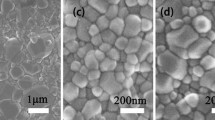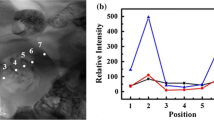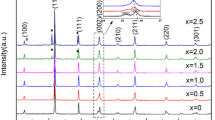Abstract
A liquid-state method was used in this work to produce Bi-BaTiO3 materials. The dielectric properties of the samples were measured by a LCR meter. With increasing Bi content, the Multilayer ceramic capacitors display a stronger performance in its dielectric behavior. The best dielectric properties was obtained in the composition x = 0.02 with ɛ = 17561. The dielectric strength of the ceramics was measured by a withstanding voltage tester. The best dielectric strength was achieved in the comp+osition x = 0.02 with E = 4.545 kV mm−1.
Similar content being viewed by others
References
Kang, J.H., Cha, H.M., Jung, Y.G.., and Paik, U., J. Materials Processing Technology, 2008, vol. 205, pp. 160–167.
Feteira, A., Sinclair, D.C., and Kreisel, J., J. Am. Ceramic Soc., 2010, vol. 93, pp. 4174–4181.
Kim, Y.K., Jung, Y.G., Sung, T.H., Kim, D.H., and Paik, U., J. Mat. Proc. Technology, 2004, vol. 152, pp. 276–283.
Lee, Y.C. and Chiang, C.S., J. Alloys & Compounds, 2011, vol. 509, pp. 6973–6979.
Zhan, X.X., Cui, B., and Xing, Y.L., Ceramics Int., 2012, vol. 38, pp. 389–394.
Wei, L.X. and Cui, B., Preparation and Research of Y5Vtype Barium Titan ate-based Nanopowders and Dielectric Ceram ics by Sol-Gel Method, Northwest University, 2010.
Tian, Z.B., Wang, X.H., Zhang, Y.C., Fang, J., Song, T.H., Hur, K.H., Lee, S., and Li, L.T., J. Am. Ceramic Soc, 2010, pp. 171–175.
Raengthon, N., DeRose, V.J., Brennecka, G.L., and Cann, D.P., Appl. Phys. Let., 2012, vol. 101, p. 112904.
Jain, T.A. Fung, K.Z., and Chan, J., J. Alloys & Compounds, 2009, vol. 468, pp 370–374.
Wang, S.F. and Tu, C.S., J. Appl. Phys, 2014, vol. 116, p. 154101.
Tu, C.S., Chien, R.R., and Wang, T.H., J. Appl. Phys., 2013, vo1. 113, p. 17D908.
Maurya, D., Pramanick, A., and An, K., Appl. Phys. Let., 2012, vol. 100, p. 172906.
Wang, Y. and Cui, B., Ceramics Int., 2014, vol. 40, pp. 11681–11688.
Wang, J. Jiang, S.L., and Song, L.H., Modern Phys. Let., B, 2013, nol. 27, no. 4, p. 1350026.
Wang, J., Jiang, S.L., and Jiang, D., Ceramics Int., 2013, vol. 39, pp. 3657–3662.
Wang, J., Jiang, S.L., and Jiang, D., Ceramics Int., 2012, vol. 38, pp. 5853–5857.
Park, Y., Kim, Y., and Kim, H.G., J. Appl. Phys., 1996, vol. 29, pp. 2483–2491.
Cernea, M., Vasile, B.S., Boni, A., and Iuga, A., J. Alloys & Compounds, 2014, vol. 587, pp. 553–559.
Uddin, S., Zheng, G.P., Iqbal, Y., Ubic, R., and Yang, J., J. Appl. Phys., 2013, vol. 114, p. 213519.
Wang, S.F., Tu, C.S., Chang, T.L., Chen, P.Y., Chen, C.S. Schmidt, V.H., and Anthoniappen, J., J. Appl. Phys., 2014, vol. 116, p. 154101.
Zhan, X.X., Cui, B., and Xing, Y.L., Ceramics Int., 2012, vol. 38, pp. 389–394
Zhai, J.W., Shen, B., Yao, X., and Zhang, L.Y., J. Am. Ceramic Soc., 2004, vol. 87 12. pp. 2223–2227.
Shen, Z.B. and Wang, X.H., Ceramics Int., 2014, vol. 40, pp. 13833–13839.
Author information
Authors and Affiliations
Corresponding author
Additional information
The text was submitted by the authors in English.
Rights and permissions
About this article
Cite this article
Wang, J., Rong, G., Li, N. et al. Dielectric properties of Bi-Doped BaTiO3-based ceramics synthesized by liquid-state method. Russ J Appl Chem 88, 533–537 (2015). https://doi.org/10.1134/S107042721503026X
Received:
Published:
Issue Date:
DOI: https://doi.org/10.1134/S107042721503026X




